A Level Media Studies
Curriculum overview for A Level Media Studies
Curriculum intent – the knowledge, understanding and skills that students will learn
This is a highly academic course in which students engage with a large number of case studies set over a number of media platforms, to understand, analyse, and evaluate the codes and conventions of advertising for television and print, UK newspaper journalism, music videos, film, radio, video games, television crime drama, magazines, and online content via websites and social media influencers. This understanding is developed through academic theories broken down into four sections: media language, representation theories, audience theories and investigations into industry practice. From this knowledge, students will be able to understand the role that media takes in their day to day lives beyond entertainment, examining the industrial and business processes and decisions that are made when developing media products, as well as how perceptions of different groups are formed via media products, with a particular focus on gender, gender identities, and race/ethnicity. Skills developed by students over the course include academic writing, extracting information and developing judgements and opinions; evaluating the theories studied, extracting information from academic sources and researching specific media contexts; evaluating their own use of social media and the impact it can have on creators and viewers.
Curriculum implementation – teaching, learning and assessment strategies
Students are expected to complete wider research of the contemporary media landscape by keeping up to date with recent legal and legislative developments in the different media platform areas. A wider reading list is available on Teams and displayed in the teaching space, and the department subscribes to Media Magazine, all copies of which are kept on Teams and the Student Shared Drive. It includes further articles in each edition relating to a specific case study or academic theory, written in a light academic style to introduce students to the format. In-class teaching starts by looking at specific theories in general, relating them to contemporary products that the students may be more familiar with, before applying them to the specific products set by the exam board. These theories are then reinforced via repetition as they are applied to subsequent case studies, allowing academic theory to cement while we explore the context of those case studies. Students are able to access different perspectives and ideologies, often ones they have not recognised or been introduced to in their day-to-day lives, specifically how the thinking relates to representation of social groups, and how the media can impact and shape audience perspectives on the world. As two thirds of the qualification is examined through written exam papers, there are regular timed, handwritten, exam condition writing exercises to develop students’ ability to write academically in a short amount of time. In-class research activities which apply theories to personal choice case studies ensure that theories are kept relevant to the students.
Curriculum impact – intended outcomes for students
By the end of the course, students will be able to demonstrate skills of enquiry, critical thinking, decision-making and analysis; demonstrate a critical approach to media issues; demonstrate appreciation and critical understanding of the media and their role both historically and currently in society, culture, politics and the economy; demonstrate knowledge and understanding of the global nature of the media; develop an understanding of the dynamic and changing relationships between media forms, products, industries and audiences. They will apply theoretical knowledge and specialist subject specific terminology to analyse and compare media products and the contexts in which they are produced and consumed; make informed arguments, reach substantiated judgements and draw conclusions about media issues; engage in critical debate about academic theories used in media studies; appreciate how theoretical understanding supports practice and practice supports theoretical understanding demonstrate sophisticated practical skills by providing opportunities for creative media production.
Course overview for A Level Media Studies
Exam board: Eduqas - https://www.eduqas.co.uk/media/d3fbs2s3/eduqas-a-level-media-studies-spec-from-2017-e-27-05-2021.pdf
Coursework: Yes – 30% of the qualification
Component 1: Media Products, Industries and Audiences (35% of the qualification)
Section A: Analysing Media Language and Representation
Section B: Understanding Media Industries and Audiences
Component 2 Examination Paper: Media Forms and Products in Depth (35% of the qualification)
Section A: Television in the Global Age
Section B: Magazines: Mainstream and Alternative Media
Section C: Media in the Online Age
Component 3: Cross-Media Production Coursework (Non-Examined Assessment) (30% of the qualification)
An individual cross-media production based on two forms in response to a choice of briefs set by WJEC, applying knowledge and understanding of the theoretical framework and digital convergence.
